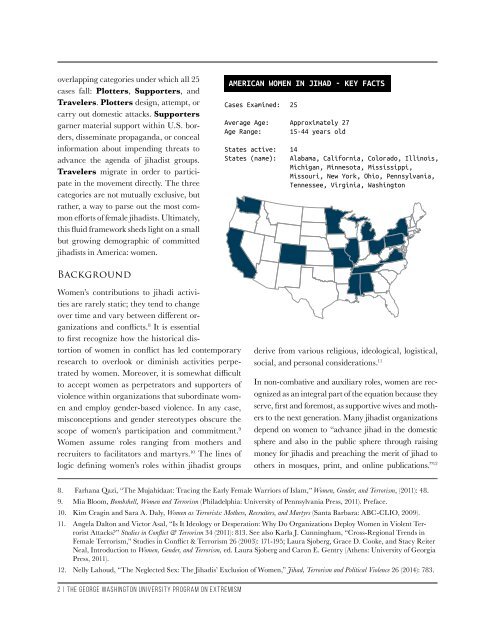Create successful ePaper yourself
Turn your PDF publications into a flip-book with our unique Google optimized e-Paper software.
overlapping categories under which all 25<br />
cases fall: Plotters, Supporters, and<br />
Travelers. Plotters design, attempt, or<br />
carry out domestic attacks. Supporters<br />
garner material support within U.S. borders,<br />
disseminate propaganda, or conceal<br />
information about impending threats to<br />
advance the agenda of jihadist groups.<br />
Travelers migrate in order to participate<br />
in the movement directly. The three<br />
categories are not mutually exclusive, but<br />
rather, a way to parse out the most common<br />
efforts of female jihadists. Ultimately,<br />
this fluid framework sheds light on a small<br />
but growing demographic of committed<br />
jihadists in America: women.<br />
AMERICAN WOMEN IN JIHAD - KEY FACTS<br />
Cases Examined: 25<br />
Average Age: Approximately 27<br />
Age Range: 15-44 years old<br />
States active: 14<br />
States (name): Alabama, California, Colorado, Illinois,<br />
Michigan, Minnesota, Mississippi,<br />
Missouri, New York, Ohio, Pennsylvania,<br />
Tennessee, Virginia, Washington<br />
Background<br />
Women’s contributions to jihadi activities<br />
are rarely static; they tend to change<br />
over time and vary between different organizations<br />
and conflicts. 8 It is essential<br />
to first recognize how the historical distortion<br />
of women in conflict has led contemporary<br />
research to overlook or diminish activities perpetrated<br />
by women. Moreover, it is somewhat difficult<br />
to accept women as perpetrators and supporters of<br />
violence within organizations that subordinate women<br />
and employ gender-based violence. In any case,<br />
misconceptions and gender stereotypes obscure the<br />
scope of women’s participation and commitment. 9<br />
Women assume roles ranging from mothers and<br />
recruiters to facilitators and martyrs. 10 The lines of<br />
logic defining women’s roles within jihadist groups<br />
derive from various religious, ideological, logistical,<br />
social, and personal considerations. 11<br />
In non-combative and auxiliary roles, women are recognized<br />
as an integral part of the equation because they<br />
serve, first and foremost, as supportive wives and mothers<br />
to the next generation. Many jihadist organizations<br />
depend on women to “advance jihad in the domestic<br />
sphere and also in the public sphere through raising<br />
money for jihadis and preaching the merit of jihad to<br />
others in mosques, print, and online publications.” 12<br />
8. Farhana Qazi, “The Mujahidaat: Tracing the Early Female Warriors of Islam,” Women, Gender, and Terrorism, (2011): 48.<br />
9. Mia Bloom, Bombshell, Women and Terrorism (Philadelphia: University of Pennsylvania Press, 2011). Preface.<br />
10. Kim Cragin and Sara A. Daly, Women as Terrorists: Mothers, Recruiters, and Martyrs (Santa Barbara: ABC-CLIO, 2009).<br />
11. Angela Dalton and Victor Asal, “Is It Ideology or Desperation: Why Do Organizations Deploy Women in Violent Terrorist<br />
Attacks?” Studies in Conflict & Terrorism 34 (2011): 813. See also Karla J. Cunningham, “Cross-Regional Trends in<br />
Female Terrorism,” Studies in Conflict & Terrorism 26 (2003): 171-195; Laura Sjoberg, Grace D. Cooke, and Stacy Reiter<br />
Neal, Introduction to Women, Gender, and Terrorism, ed. Laura Sjoberg and Caron E. Gentry (Athens: University of Georgia<br />
Press, 2011).<br />
12. Nelly Lahoud, “The Neglected Sex: The Jihadis’ Exclusion of Women,” Jihad, Terrorism and Political Violence 26 (2014): 783.<br />
2 | The George Washington University Program on Extremism




